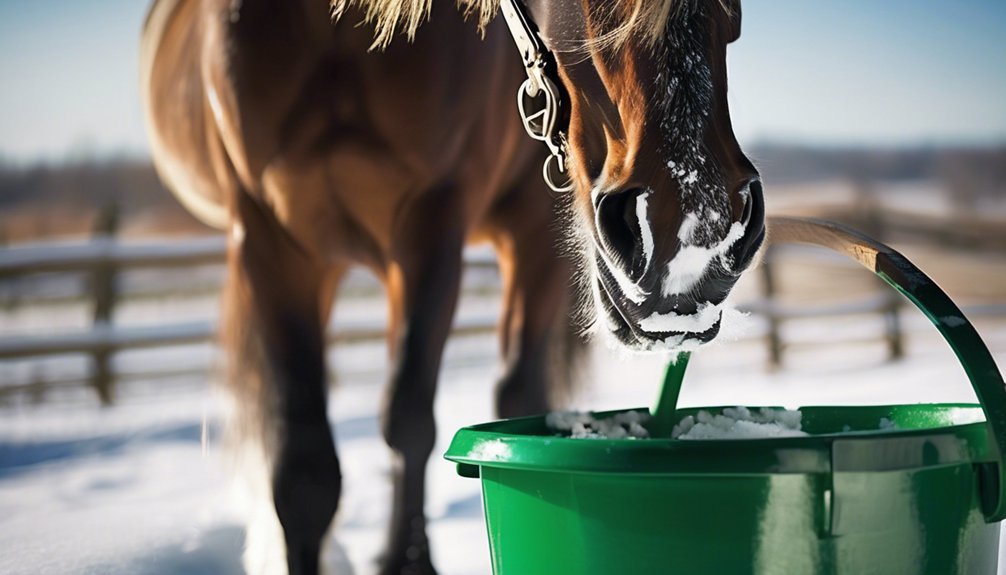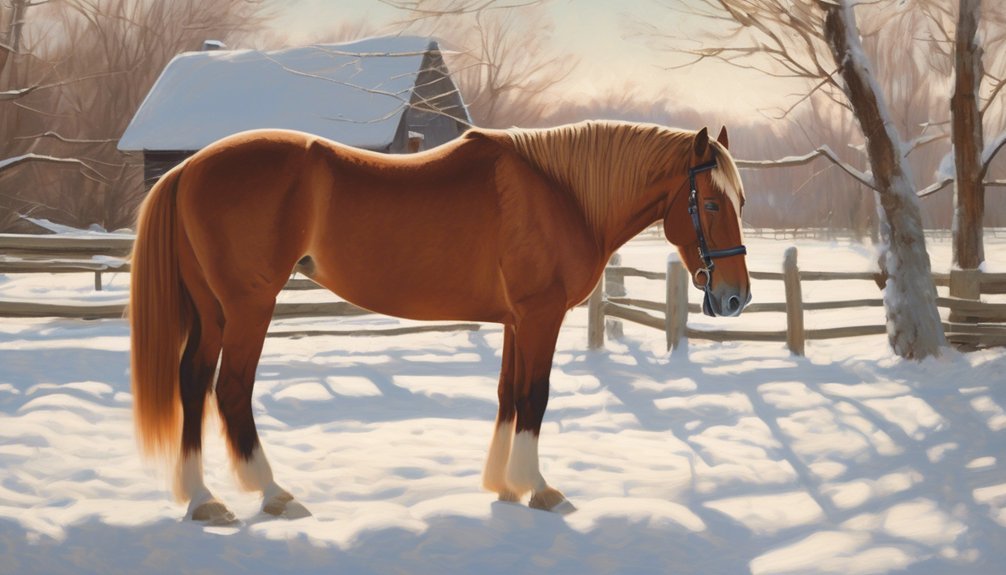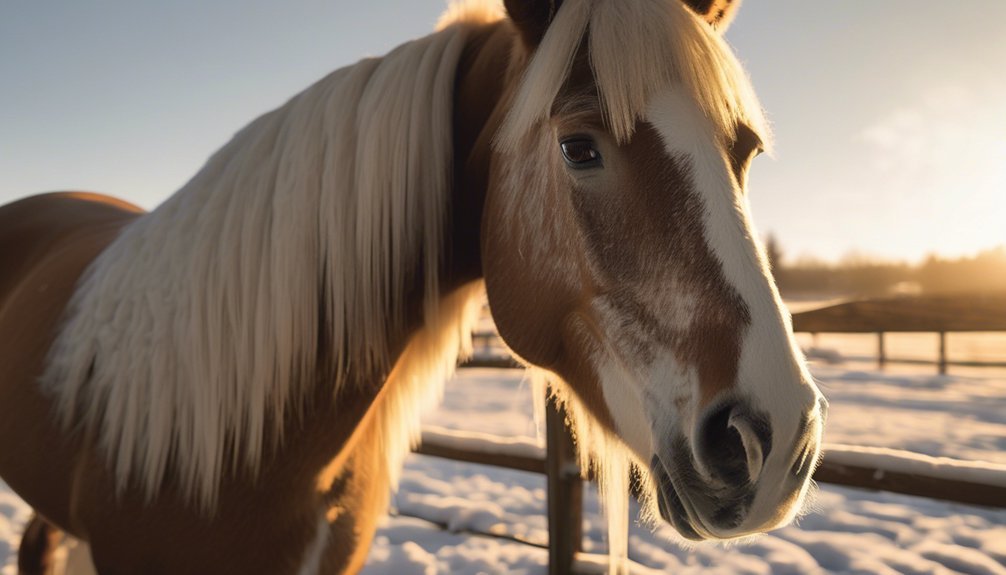
Maintaining your horse's coat during cold weather requires a strategic approach. A consistent grooming routine is essential, as it not only removes dirt but also distributes natural oils for a healthy shine. You'll need quality tools and techniques tailored for winter conditions. Additionally, nutrition plays a significant role in coat health. Understanding these elements can make a noticeable difference in your horse's appearance and comfort during the chillier months. Let's explore the best practices for winter coat care.
Key Takeaways
- Regularly groom your horse using stiff and soft brushes to distribute natural oils and stimulate circulation for a healthy coat.
- Provide a balanced diet rich in nutrients, including omega-3 fatty acids and biotin, to support optimal coat growth during cold weather.
- Use targeted supplements like coat conditioners and flaxseed oil to enhance moisture and shine in your horse's coat.
- Choose the appropriate blanket weight based on weather conditions, ensuring a proper fit to prevent rubbing and skin issues.
- Monitor for signs of discomfort, such as itching or dryness, and address any skin sensitivities promptly to maintain coat health.
Understanding the Impact of Cold Weather on Your Horse's Coat

As winter approaches, it's essential to understand how cold weather can affect your horse's coat. The cold weather effects on your horse may lead to a thicker and longer coat growth, which serves as natural insulation.
You'll notice that your horse's body instinctively adapts to the dropping temperatures, but this doesn't mean you should neglect their care. A well-groomed coat not only helps with insulation but also promotes skin health.
Pay attention to your horse's nutritional needs, as a balanced diet supports optimal coat growth and quality. Regularly check for any signs of discomfort, such as excessive itching or dryness, as these may indicate that your horse needs extra attention during the colder months.
Essential Grooming Techniques for Winter
With the onset of winter, grooming your horse becomes even more important to ensure their coat remains healthy and vibrant.
Start with quality grooming tools, like a stiff brush to remove dirt and loose hair, followed by a softer brush for a polished finish. Winter brushing is essential; it not only helps distribute natural oils but also stimulates circulation.
Take your time, working in sections to make sure every area gets attention. Don't forget to check for any skin issues, as the cold can exacerbate sensitivities. A good curry comb can work wonders in loosening debris while providing a gentle massage.
Finally, always finish with a thorough inspection to keep your horse's coat in top condition throughout the chilly months.
The Importance of Proper Nutrition

Proper nutrition plays a crucial role in maintaining your horse's coat during the cold months. A well-balanced diet rich in essential nutrients ensures your horse's skin stays healthy and produces natural coat oils that keep it shiny and protected. Focus on high-quality forage, grains, and supplements that provide the necessary nutrient sources.
Here's a quick overview of beneficial nutrients:
| Nutrient | Role in Coat Health |
|---|---|
| Omega-3 Fatty Acids | Promote coat oils and shine |
| Biotin | Supports hoof and skin health |
| Vitamins A & E | Helps skin repair and shine |
| Protein | Essential for hair growth |
Supplements to Support Coat Health
While a balanced diet lays the foundation for your horse's coat health, incorporating targeted supplements can significantly enhance its quality during the colder months.
Consider adding coat conditioners rich in omega fatty acids, which help maintain moisture and shine. Flaxseed oil or fish oil are excellent sources that can support the skin's barrier, preventing dryness and flakiness.
Additionally, biotin and zinc can strengthen hair follicles, promoting growth and resilience. When selecting supplements, opt for those specifically formulated for coat health, ensuring they contain high-quality ingredients.
Always consult your veterinarian before introducing new supplements, as they can provide personalized advice tailored to your horse's unique needs.
With the right support, your horse's coat can remain lustrous and healthy throughout winter.
Managing Blanketing Practices

As temperatures drop, managing your horse's blanketing practices becomes essential to ensure their comfort and well-being. Understanding blanket types and proper fitting techniques can make all the difference.
| Blanket Type | Ideal Use |
|---|---|
| Heavyweight | Extremely cold weather |
| Medium-weight | Chilly, dry conditions |
| Lightweight | Mild, damp weather |
When choosing a blanket, assess your horse's coat condition and body type. Ensure the blanket fits snugly across the shoulders and doesn't rub or restrict movement. Regularly check for dirt or moisture underneath, as this can lead to skin issues. By carefully selecting and fitting your horse's blanket, you'll help maintain their coat health during the cold months.
Hydration: Keeping Your Horse Well-Watered
Maintaining your horse's hydration during cold weather is crucial, especially since they may not drink as much as they do in warmer months.
Focus on water quality; clean, fresh water is essential for encouraging your horse to drink. Check troughs regularly and ensure they're free from ice and debris.
Consider using hydration methods like warm water or adding electrolytes to their feed, which can stimulate thirst. Providing smaller, more frequent amounts of water can also help maintain their interest.
If your horse is reluctant to drink, try offering water in buckets rather than troughs, as they may prefer the change.
Keeping your horse well-watered not only supports their overall health but also helps maintain that beautiful coat you cherish.
Regular Health Checks for Skin and Coat Issues

To keep your horse's coat healthy during the cold months, regular health checks are essential for identifying any skin or coat issues early on. Make it a habit to perform skin inspections weekly, looking for signs of irritation, dryness, or parasites. Pay attention to your horse's coat conditions, as changes can indicate underlying health problems. Incorporating a systematic approach can make these checks efficient.
| Inspection Area | What to Look For | Action to Take |
|---|---|---|
| Coat Texture | Dryness, brittleness | Adjust diet, add oils |
| Skin Condition | Redness, swelling | Consult your vet |
| Mane & Tail | Breakage, loss of hair | Use moisturizing products |
| Hooves | Cracks, thrush signs | Regular farrier visits |
| Overall Health | Changes in behavior/appetite | Schedule a vet visit |
Frequently Asked Questions
Can I Use Human Grooming Products on My Horse's Coat?
You shouldn't use human grooming products on your horse's coat due to potential human product safety issues. Instead, consider grooming product alternatives specifically designed for equines, ensuring your horse stays healthy and comfortable.
How Often Should I Bathe My Horse in Winter?
You should limit bath frequency during winter to avoid chilling your horse. Instead, focus on regular grooming for coat care. A damp sponge bath can refresh without soaking, ensuring your horse stays comfortable and clean.
Are There Specific Brushes Recommended for Winter Grooming?
For winter grooming, you'll want to use sturdy winter brushes designed to remove dirt and loose hair effectively. A rubber curry comb followed by a soft-bristled finishing brush ensures your horse's coat stays healthy and shiny.
Is It Safe to Clip My Horse's Coat During Cold Weather?
Clipping your horse's coat in cold weather can be safe if done carefully. Use proper clipping techniques to avoid excessive chill and maintain coat health. Always monitor your horse's comfort and adjust grooming accordingly.
What Signs Indicate My Horse Is Too Cold or Uncomfortable?
When the winter's chill wraps around your horse like a heavy cloak, watch for signs of discomfort—shivering, tucked legs, or a drooping head. Their body language speaks volumes about their struggle with temperature regulation.
Conclusion
In the chill of winter, your horse's coat can either thrive or suffer, depending on your care. By balancing diligent grooming with a nutritious diet, you foster a healthy, resilient coat that withstands the elements. While the cold can strip away shine and vitality, your attentive practices can restore and maintain it. Remember, a well-groomed horse not only looks good but feels good, too, making your efforts a vital part of their winter wellness.





